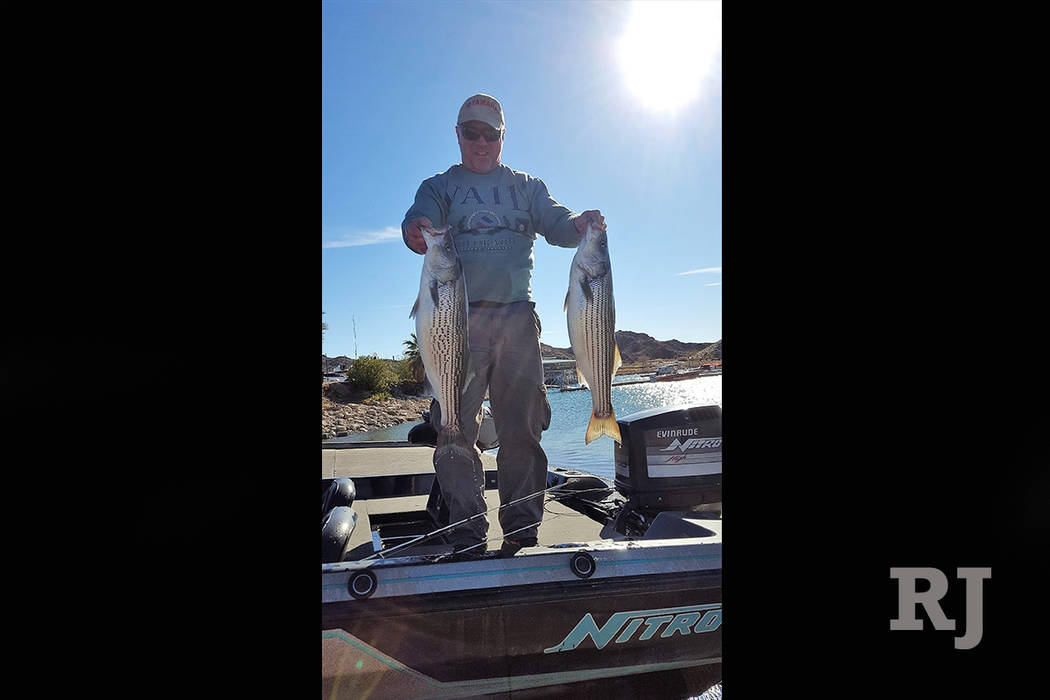Treat yourself to a trip to Lake Mead or Lake Mohave

Whether you are interested in catching a double-digit striped bass or spending a relaxing day exploring one of Southern Nevada’s reservoirs, don’t let the holiday season pass without taking a trip to Lake Mead or Lake Mohave.
With the seemingly endless winds of summer now gone, some of the best boating water of the year is available. Combine that with low boater numbers and you have the recipe for a pleasurable boating experience.
During my game warden years, the cool months from November through February were always the most enjoyable time to be on the water. It was almost always glass smooth, and my patrol boat just seemed to glide across its surface rather than bounce over it as it did during the hot summer months when windy conditions and high boater numbers are the norm.
While the early morning hours can be on the cool side this time of year, you really don’t need much more than a warm jacket and something to keep your head warm while you are waiting for the sun to bring the heat. OK, heat is probably not the right descriptor, but our midday winter temperatures are relatively comfortable compared to those of other boating destinations farther north.
Even though water levels are on the low side, Lake Mead and Lake Mohave still offer a lot of open water to explore, and each one has its own personality. For boaters who like big, open water, Lake Mead is the place, while those who prefer a smaller feel will probably prefer Lake Mohave.
It’s not as if Lake Mohave is all that small, but it is long, narrow and lined with hundreds of coves and bays. In some ways it provides a more intimate experience that its larger sister to the north. Lake Mead, on the other hand, is comprised of large basins connected by passages that reflect a narrowing of canyons that lay beneath the water’s surface.
Both reservoirs provide excellent fishing for striped bass, largemouth bass, smallmouth bass, catfish and a variety of pan fish. Among the latter are healthy populations of aggressive and hard fighting bluegills. In recent years, the crappie fishery at Lake Mead has experienced a significant resurgence and offers anglers good action during the cooler months of the year, especially from midwinter into early spring.
Just as each of these reservoirs has its own physical personality, they are just as individual when it comes to the fishing they provide. It has been said that anglers looking to catch large numbers of fish should go to Lake Mead, and those who are hoping to catch big fish should go to Lake Mohave.
Through the years, Lake Mohave has given up some rather large fish. Most notable are striped bass that push well beyond 30 pounds and are often found in the cold waters near Willow Beach. But not far behind are hefty smallmouth bass whose population has exploded in recent years. Smallies pushing beyond 4 pounds are becoming increasingly common.
Not every angler who launches a boat on Lake Mohave catches a striper that tips the scale at more than 30 pounds, but fish pushing toward the double-digit range are common, especially during the cool months.
During a recent outing on Lake Mohave, my friend Roger Williams caught three stripers that weighed in at 9, 8.5 and 5 pounds.
While sharing his fish story, Roger told me that as he reeled in each fish, they were followed by a school of fish that were even larger than the three. Within the schools were fish he thought would easily surpass the 10-pound mark.
Roger was casting shad imitations and swimbaits toward the shoreline, where he could see the stripers feeding on shad. Of note were the stomach contents of each fish. The two largest fish had 6- to 8-inch stripers in the stomachs as well as shad. The 5-pound fish had been eating only shad. That knowledge should help guide your choice of baits.
The fish hit his lure so hard, Roger said, that it just suddenly stopped. Then the fish fought him all the way back to the boat. Not a bad way to spend a December day.
Freelance writer Doug Nielsen is a conservation educator for the Nevada Department of Wildlife. His “In the Outdoors” column, published Thursday in the Las Vegas Review-Journal, is not affiliated with or endorsed by the NDOW. Any opinions are his own. Find him on Facebook at @dougwritesoutdoors. He can be reached at intheoutdoorslv@gmail.com.












